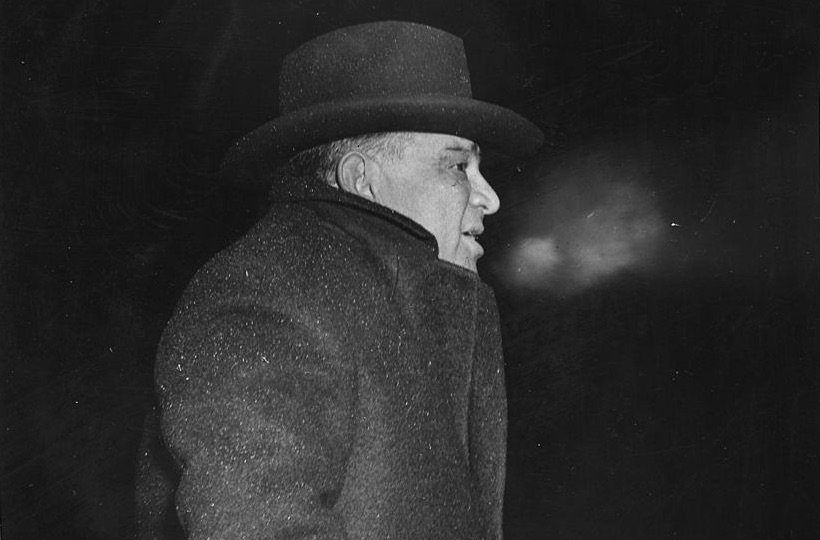

[NOW: July 28, 2014—VS—THEN: October 7, 1935]
Seventy-nine years later, I’m trying to match a scene Berenice Abbott (1898-1991) caught from the corner of Broome and Crosby Streets. She was working for the Federal Arts Project (FAP) at the time and compiling material for a book of photography that would later be called Changing New York [1939]. A subprogram of the Works Progress Administration (WPA), FAP was President Franklin D. Roosevelt’s way of helping artists across the country supplement their income during the Great Depression. Thanks to FAP’s stipend of $24 per week — or, $415.94 in 2014 terms — Abbott was able to support herself from 1935 to 1939 and produce over 300 images for her book. This was one of the coolest.
Thankfully, the grand office at the center of her shot still stands. It’s not only been marked by two different names over the years (the Silk Exchange and Haggin Building), but also three distinct addresses (487 Broadway, 443-449 Broome, and 60 Mercer Street).
Erected between March 27, 1895 and April 4, 1896, the building’s owner John Townsend Williams (1852-1915) was also its architect. He left behind other works in the neighborhood too, including a warehouse across the street at 450-452 Broome and a loft building two blocks east at 416-422 Broome.
In 1973, when the Landmarks Preservation Commission (LPC) created the SoHo-Cast Iron Historic District, 487 Broadway was formerly protected. Here’s how the LPC characterized it in the official report:
[487 Broadway] is a late 19th-century extravaganza in stone, brick, terra cotta and iron, stretching along the entire block front of Broome Street for an impressive 29 bays. Its twelve stores and wide expanse were made possible only by the development of steel framing and skyscraper construction techniques of the late 19th century.
Its top three stories were a particular treat:
The pilasters dividing the windows as well as the spandrel arches contain elaborately florid Baroque terra-cotta ornamental details…. [and] its cornice is supported by elaborately molded brackets.
So just how important was the mapping of this new district? Well, it gave 487 Broadway and its companions a buttress against the wrecking ball.
Believe it or not, the area was once deemed expendable. During the 1960s, City Construction Coordinator Robert Moses (1888-1981) wanted to use this part of SoHo to connect the Holland Tunnel to the Manhattan and Williamsburg Bridges. To realize his Lower Manhattan Expressway, or LOMEX, he planned to demolish everything between Broome and Kenmare Streets from 6th Avenue to Chrystie Street. In the process, over 800 businesses and some 2,000 families from across SoHo, Little Italy, and Chinatown were slated for eviction.
Really.
If Moses had gotten his way, my “Now” photo would have had an eight-lane elevated highway running along the right-hand side of the frame. The buildings on the left, including 487 Broadway, would have probably looked smoke-spattered and diminutive in comparison.
Don’t believe me? Well, check out the illustration below. The blue arrow points to 487 Broadway and the yellow dot marks the position of my camera — which would have actually been under the big thoroughfare:
Scary, isn’t it?
Thankfully, none of this came to pass. A diverse coalition of local residents organized themselves as the “Stop the Lower Manhattan Expressway Committee” to defeat Moses’ project. For nearly a decade, as the idea was resuscitated again and again, the Committee kept resisting. Moses needed around $90 million from the federal government and $10 million from the state to begin construction, and their persistence hampered his efforts. In 1971, when Governor Nelson A. Rockefeller (1908-1979) pulled the state’s funding, the LOMEX was finally dead.
From the northwest corner of Broome and Crosby Streets looking west at the Silk Exchange Building.
(NOW) Photo by Rick Stachura. July 28, 2014.
(THEN) Photo by Berenice Abbott. Courtesy of the Museum of the City of New York. October 7, 1935.
(IMAGE) Illustration by Unknown. Cover of the pamphlet “Cross Manhattan Arterials and Related Improvements.” Courtesy of the Hagley Museum. Originally published by the Triborough Bridge and Tunnel Authority, the Robert Moses-controlled agency, to promote the Lower Manhattan Expressway. November 12, 1959.
(Part of this story was originally published to my old Tumblr site on December 17, 2014.)


1 comment for “Berenice on Broome”